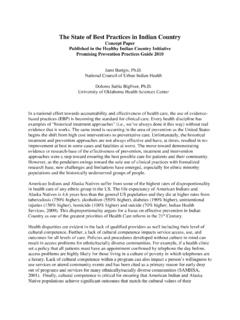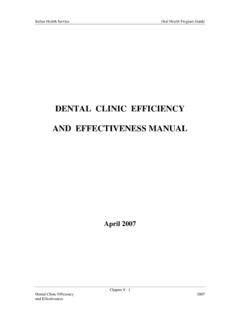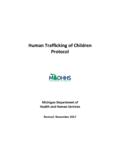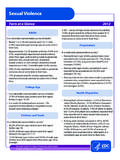Transcription of Part I: Target Product Profile (TPP) for the Advance ...
1 Part I: Target Product Profile (TPP). for the Advance Market commitment (AMC). for pneumococcal conjugate Vaccines Master Table The Product specifications tabled below are called the Target Product Profile (TPP). The specifications relate to the public health impact and suitability of the Product , covering measures of vaccine efficacy, safety, dose- scheduling, presentation and packaging, and represent the minimally acceptable standard a vaccine needs to meet in order to be eligible for AMC support. This table must be read in conjunction with the accompanying Part II.
2 TPP Supplementary Information that provides the rationale for the selected criteria, and proposes more advanced Product characteristics, that are desirable but not essential. For other pneumococcal vaccine types, such as protein-based vaccines, several attributes will require adaptation. Attribute Minimally Acceptable Profile A. Vaccine serotypes The serotypes in the vaccine formulation must cover at least 60% of the invasive disease isolates in the Target region, and must include serotypes 1, 5. and 14 which are the most frequent isolates in GAVI eligible countries.
3 B. Immunogenicity Immunogenicity should be demonstrated in accordance with WHO criteria, which are based on non-inferiority to a licensed pneumococcal vaccine as outlined in WHO Recommendations for the production and control of pneumococcal conjugate vaccines. (WHO Technical Report Series, No 927, 2005 and any subsequent published guidance). C. Target population/ The vaccine must be designed to prevent disease among children <5 years of Target age groups age and in particularly be effective in those < 2 years of age. D. Safety, reactogenicity The safety and reactogenicity Profile should be comparable to, or better than and contra-indications that of the currently licensed pneumococcal conjugate vaccine.
4 Contra- indications should be restricted to known hypersensitivity to any of the vaccine components. E. Dosage schedule Vaccine scheduling must be compatible with national infant immunization programmes and consist of not more than 3 doses in the first year of life. The first dose must be shown to be administrable at 6 weeks of life or earlier. Page 1 02/22/2008. F. Interference and co- There should be no clinically significant interaction or interference in administration with relation to safety and immunogenicity with concurrently administered other vaccines vaccines.
5 G. Route of administration Intramuscular or subcutaneous. H. Product presentation The vaccine must be available in mono-dose or low multi-dose presentations. Mono-doses can be either a single dose vial or a non-reusable compact pre-filled device. Low multi-dose presentations should be formulated in compliance with multi-dose vial policy (The use of opened multi-dose vials of vaccine in subsequent immunization sessions, WHO/V& ). I. Product formulation Liquid formulation with a standard volume of ml/dose. J. Storage and cold chain The Product must be stable at 2-8 C with a shelf-life of at least 24 months requirements and a vaccine vial monitor should be attached as outlined in Making use of vaccine vial monitors.
6 Flexible vaccine management for polio (WHO/V& ). K. Packaging and labeling Name and labelling must be in accordance with WHO Recommendations for the production and control of pneumococcal conjugate vaccines. (WHO. Technical Report Series, No 927, 2005). Packaging must ensure minimal storage space requirements as set out in Guidelines on the international packaging and shipping of vaccines (WHO/ ). L. Product registration The Product must be WHO pre-qualified in accordance with Procedures for and prequalification assessing the acceptability, in principle, of vaccines for purchase by United Nations agencies (WHO/ ).
7 M. Post marketing Post-marketing surveillance should be conducted in accordance with surveillance national regulatory authorities and WHO prequalification requirements as set out in Guideline for preparation of the Product summary file for vaccine prequalification (WHO/ ) , Guidelines on clinical evaluation of vaccines: regulatory expectations (WHO Technical Report Series, No 924, 2004) and any relevant published guidance. Page 2 02/22/2008. Part II: Target Product Profile (TPP). for the Advance Market commitment (AMC). for pneumococcal conjugate Vaccines Supplementary Information Contents Abbreviations.
8 3. I. Statement of II. General introduction ..7. II. General introduction ..7. A. S. pneumoniae and pneumococcal 7. B. pneumococcal carriage .. 8. C. Current conjugate vaccines .. 8. (i) pneumococcal conjugate vaccine efficacy trials .. 9. (ii) Vaccine effectiveness following introduction into national immunization campaigns (direct and indirect effects) .. 10. (iii) Serotype replacement .. 12. D. Cost-effectiveness .. 13. E. Protein based 14. III. Vaccine characteristics relevant to the Target Product A. Vaccine serotypes .. 15. B. Immunogenicity.
9 18. C. Target population/ Target age groups .. 20. D. Safety, reactogenicity and contra-indications .. 20. E. Vaccine dosage 21. F. Interference and co-administration with other vaccines .. 23. G. Route of 24. H. Product 25. I. Product formulation .. 26. J. Storage and cold chain requirements .. 26. K. Vaccine packaging and labelling .. 27. L. Product registration and 27. M. Post marketing surveillance .. 28. V. Contributors ..29. VI. WHO policy documents cited in the text ..31. VII. Page 2 22/02/2008. Abbreviations ABCs Active Bacterial Core Surveillance AIDS Acquired Immunodeficiency Syndrome AMC Advance Market commitment ARIVAC trial Acute Respiratory Infection Vaccine trial BCG Bacille Calmette-Gu rin CDC Centers for Disease Control and Prevention CI Confidence Interval CRM197 Cross Reactive Material of Diphtheria Toxin DALY Disability Adjusted Life Years DTwP Diphtheria-Tetanus-whole Cell Pertussis Combination vaccine DTaP Diphtheria-Tetanus acellular Pertussis Combination vaccine ELISA Enzyme-Linked Immunosorbent Assay EPI Expanded
10 Program on Immunization FDA Food and Drug Administration FT Full Term GAVI Alliance The Global Alliance for Vaccines and Immunization GSP Global Serotype Project GSKBio GlaxoSmithKline Biologicals GMC Geometric Mean Concentration GACVS Global Advisory Committee on Vaccine Safety Hib Haemophilus Influenzae type b HIV Human Immunodeficiency Virus IPV Inactivated Polio Vaccine IM Intramuscular LBW Low Birth Weight MDVP Multi-Dose Vial Policy NRA National Regulatory Authority NCKP Northern California Kaiser Permanente OPV Oral Polio Vaccine OPA Opsonophagocytic Assay PATH Program for Appropriate Technology in Health PCV pneumococcal conjugate Vaccine PHiD-CV pneumococcal Haemophilus influenzae Protein D conjugate Vaccine Page 3 22/02/2008.

















